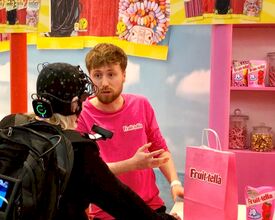What goes around in people's brains when they attend a live event, such as a trade show? A unique brain study examined the effect of a trade fair visit on the subconscious. Neuroscience bureau Neurensics has compared the impact of live events with other commercial contact moments such as commercials.
The research firm showed through special NIRS (Near Infra Red Spectography) equipment and MRI scans that the value of a live contact is of a different order, more conscious and unconscious attention to the message, than that of a delayed or digital contact. It also became clear that video cannot replace an event, but it can extend the life of an event. It are our colleagues from Eventbranche and their partners RAI Amsterdam, DPG Media, D&B Eventmarketing and Party Rent Group who took the initiative for this research. They want to scientifically prove the added value of live events.
Two studies
Scientists have equipped a representative group of 24 visitors to a Dutch tradeshow, with NIRS equipment that registers the unconscious assessment of observations. Contact moments with exhibitors Weleda, Fruittella and The Famous Grouse were recorded on video. The compilation of these images representing the tradeshow visit was shown to a second group of 24 respondents. This gave them a 'deferred' exhibition experience that was measured via an MRI scanner. The researchers paid attention to emotions in the brain and whether that activation lead to a positive or negative assessment.
Personal and direct contact is more effective
It seems that when someone is approached personally, the brain 'consciously' searches for the 'processing of information' at an avent. This information is then evaluated in order to reach a conclusion. For example: store new information or buy something. To see whether this effect applies specifically to a live event, or whether this also applies to forms of advertising such as TV commercials, the experiment was expanded to include the second study. "A special area in the brain actively lights up in a live event, which is not or much less activated when watching a video", says Martin de Munnik co-founder of Neurensics. "This part of the brain is mainly involved in assessing the factual information that is being presented. The amount of energy the brain uses here is much greater than in the control group. We see this as an investment that the brain makes in gathering data, knowledge and that it is an explanation for the fact that a personal and direct contact is much more effective than a delayed contact."
More activity in the brain during a live event
Simply put, our brain works with facts and emotions, the sum of which leads to behavior, in this case 'wanting to buy something' or 'not'. That decision itself is always emotional. What distinguishes us from other animal species is that we humans have reason. Looking for what makes a live event so special, the scientists saw that it is mainly the activity in the area in the front of the brain, the Dorsolateral Prefrontal Cortex (DLPFC). This part of the brain is thought to be responsible for planning and higher aspects of control, such as 'monitoring' behavior and suppressing unwanted behavior. Especially processing the logic and structure of cognitive, factual information creates a lot of activity in this part of the brain. For example, the deeper emotional brain would like to decide to buy a certain product. It is then the DLPFC, as this area is also called, that can make some sort of last rational intervention: yes, because reliable and competent, or no, because not sensible, unhealthy.
Lean-in: the brain invests
A comparison of the brain activation of a tradeshow visit with that of seeing a video such as commercials shows that the brain - thanks to the personal approach - is 'consciously' looking for information at a tradeshow. In case of the commercial the information is passively processed. Sjoerd Weikamp, owner of EventBranche: "The scientists at Neurensics have called this difference lean-in and lean-back: lean-in proactively processes information. This requires a lot of energy. We can literally speak of an 'investment' the brain makes in gathering, processing and assessing knowledge. This may explain why the effect of advertising on sales costs so many contacts and thus so much time and money, where a trade fair, event or showroom visit quickly leads to a positive attitude or a direct sale. "
The value of live events
De Munnik: "What advertisers can learn from this study? This research shows that the value of a live contact is of a different order than that of a postponed or digital contact. During live contact, the scientists saw that the message was processed much more actively in the brain. During live contact, the brain is not only unconsciously, but also consciously engaged in processing the information, whether during the event visit or at the moment of the interaction between customer and seller. A good product proposition consists of a promise and the evidence. We then see that the brain wants to take the trouble to process and store the factual information. The personal approach that can give live through eye contact, a smile and non-verbal signals and a conversation seems to be the key here to make this investment."
An event is therefore ideally suited to lay the foundation for a communication strategy that requires demonstration or factual explanation. For example during major changes within a company, during introductions or important moments. Products and services that require an explanation or whose value must be substantiated with facts should also opt for a form of a live event. The proactive attitude of the brain means that an investment is made in a valuable relationship.



